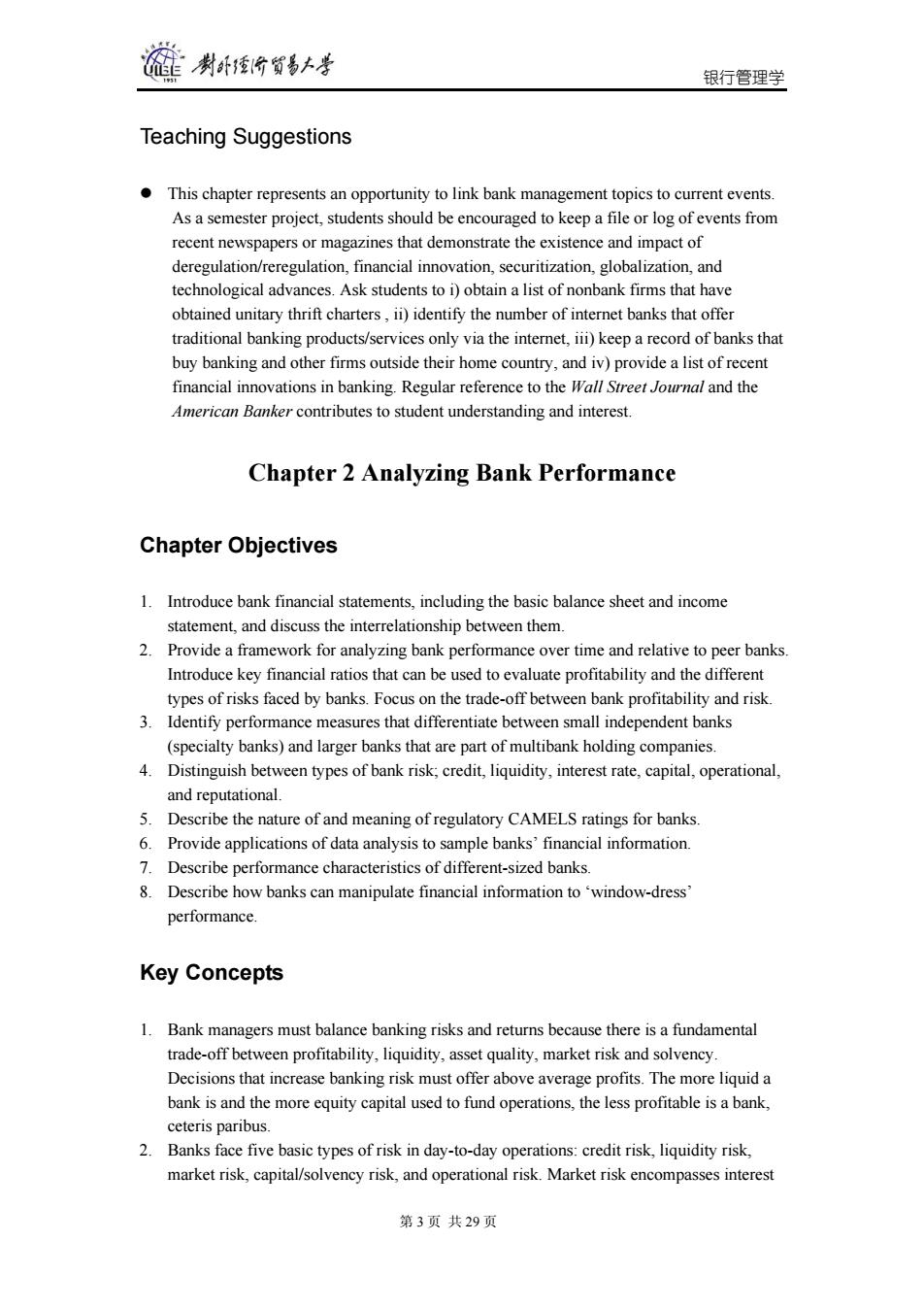正在加载图片...

雄 制卧台贸多上考 银行管理学 Teaching Suggestions This chapter represents an opportunity to link bank management topics to current events. As a semester project,students should be encouraged to keep a file or log of events from recent newspapers or magazines that demonstrate the existence and impact of deregulation/reregulation,financial innovation,securitization,globalization,and technological advances.Ask students to i)obtain a list of nonbank firms that have obtained unitary thrift charters,ii)identify the number of internet banks that offer traditional banking products/services only via the internet,iii)keep a record of banks that buy banking and other firms outside their home country,and iv)provide a list of recent financial innovations in banking.Regular reference to the Wall Street Journal and the American Banker contributes to student understanding and interest. Chapter 2 Analyzing Bank Performance Chapter Objectives 1.Introduce bank financial statements,including the basic balance sheet and income statement,and discuss the interrelationship between them. 2.Provide a framework for analyzing bank performance over time and relative to peer banks. Introduce key financial ratios that can be used to evaluate profitability and the different types of risks faced by banks.Focus on the trade-off between bank profitability and risk. 3.Identify performance measures that differentiate between small independent banks (specialty banks)and larger banks that are part of multibank holding companies. 4.Distinguish between types of bank risk,credit,liquidity,interest rate,capital,operational, and reputational. 5.Describe the nature of and meaning of regulatory CAMELS ratings for banks. 6. Provide applications of data analysis to sample banks'financial information. 7.Describe performance characteristics of different-sized banks. 8. Describe how banks can manipulate financial information to 'window-dress performance. Key Concepts 1.Bank managers must balance banking risks and returns because there is a fundamental trade-off between profitability,liquidity,asset quality,market risk and solvency. Decisions that increase banking risk must offer above average profits.The more liquid a bank is and the more equity capital used to fund operations,the less profitable is a bank, ceteris paribus. 2.Banks face five basic types of risk in day-to-day operations:credit risk,liquidity risk, market risk,capital/solvency risk,and operational risk.Market risk encompasses interest 第3页共29页银行管理学 第 3 页 共 29 页 Teaching Suggestions z This chapter represents an opportunity to link bank management topics to current events. As a semester project, students should be encouraged to keep a file or log of events from recent newspapers or magazines that demonstrate the existence and impact of deregulation/reregulation, financial innovation, securitization, globalization, and technological advances. Ask students to i) obtain a list of nonbank firms that have obtained unitary thrift charters , ii) identify the number of internet banks that offer traditional banking products/services only via the internet, iii) keep a record of banks that buy banking and other firms outside their home country, and iv) provide a list of recent financial innovations in banking. Regular reference to the Wall Street Journal and the American Banker contributes to student understanding and interest. Chapter 2 Analyzing Bank Performance Chapter Objectives 1. Introduce bank financial statements, including the basic balance sheet and income statement, and discuss the interrelationship between them. 2. Provide a framework for analyzing bank performance over time and relative to peer banks. Introduce key financial ratios that can be used to evaluate profitability and the different types of risks faced by banks. Focus on the trade-off between bank profitability and risk. 3. Identify performance measures that differentiate between small independent banks (specialty banks) and larger banks that are part of multibank holding companies. 4. Distinguish between types of bank risk; credit, liquidity, interest rate, capital, operational, and reputational. 5. Describe the nature of and meaning of regulatory CAMELS ratings for banks. 6. Provide applications of data analysis to sample banks’ financial information. 7. Describe performance characteristics of different-sized banks. 8. Describe how banks can manipulate financial information to ‘window-dress’ performance. Key Concepts 1. Bank managers must balance banking risks and returns because there is a fundamental trade-off between profitability, liquidity, asset quality, market risk and solvency. Decisions that increase banking risk must offer above average profits. The more liquid a bank is and the more equity capital used to fund operations, the less profitable is a bank, ceteris paribus. 2. Banks face five basic types of risk in day-to-day operations: credit risk, liquidity risk, market risk, capital/solvency risk, and operational risk. Market risk encompasses interest